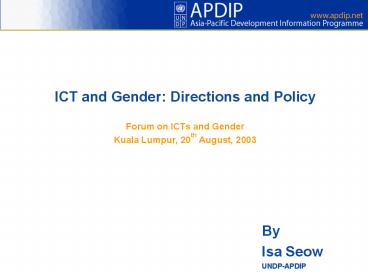ICT and Gender: Directions and Policy - PowerPoint PPT Presentation
1 / 21
Title:
ICT and Gender: Directions and Policy
Description:
Women make up to 70 % of World's poor ... See Swasti Mitter, Asian Women in the Digital Economy; see also, digitaldividedata.org ... – PowerPoint PPT presentation
Number of Views:219
Avg rating:3.0/5.0
Title: ICT and Gender: Directions and Policy
1
- ICT and Gender Directions and Policy
- Forum on ICTs and Gender
- Kuala Lumpur, 20th August, 2003
By Isa Seow UNDP-APDIP
2
ICT Access Challenges/Problems in Asia Pacific
- High costs for connectivity
- ICT infrastructure not adequate, especially in
rural areas - Low levels of literacy an underlying issue
- Less transparent policy and regulatory
environment for market access, competition, other
areas - Developing country governments have to prioritize
between water, sanitation, electricity, etc
very basic needs (huge issues) - Local language fonts and relevant content not
available - Social issue? families think men should be
educated, be in technical studies stream and
breadwinner, not women
3
Why is the Gender Issue Important?
- Women make up to 70 of Worlds poor
- UN Declaration of Human Rights makes reference to
equal status of Women - Limited Role of Women affect lives of others
family, children, etc - Womens economic and social status are important
e.g. cases of sex selective abortions - Its a social issue, and difficult to
address/resolve - The problem falls into UNDP work programmes
4
- ICT PERCENTAGE WOMEN USERS
- Latin America 38
- Europe 36
- Asia 22
- - In the three regions, Asia has the least
number of Women ICT Users. (Source Nancy and
Taggart) Harvard/Radcliffe
5
Directions for the Future
6
How Can ICT Help?
- Recognise inherent link between ICT and
Empowerment of WomenICT for sustainable
livelihood and job opportunities - GoalsTo Ensure equitable access in ICT
SectorTo Ensure ICTs contribute further to
positive change in Gender relations.
7
ICTs Empower All
- - As an economic/business tool to gain
independence (improves productivity) - As a
medium for education - Allows networking of
women / groups - Source of content about
reproductive health, disease, needs of children,
child mortality, etc - Increased bargaining
power in family and society - A two-way process,
governments gain important knowledge about
womens well being statistics, etc
8
New Work Opportunities in Digital Economy
- ICT is a medium for economic opportunities
and independence. - E-commerce,- Teleworking,
- Call Centers, Data Conversion- Medical
Transcription. - Content Development Deposition
summary. Insurance claims processing.
Geographical information systems. Web design, the
list goes on See Swasti Mitter, Asian Women in
the Digital Economy see also, digitaldividedata.o
rg
9
A Proposed Approach 3 Pronged
StrategyLiteracy, Content and Empowerment
(Policy)
- APDIPs in-house research - recommendation
was to address specific ICT and Gender problems,
not general digital divide issues thus1.
Literacy Basic skills such as reading, writing
etc important. Present literacy rates- Women make
64 of global illiterate. Also, encourage women
to move into technical fields. 2. Content
(specific content such as reproductive health,
child-care, financial resources, teleworking
information, womens groups, role models, etc)
Also support font work.
10
- 3. Empowerment Continue to support women leaders
to make high level recommendations (and policy).
To latch on and provide support, directions, etc.
Work with women leaders, women ICT specialists,
to find medium- longer term solutions also
provide jobs/employment.
11
- At its most foundational levela practical
approachTo include a Gender analysis, or
perspective wherever possible, from proposals to
projects, policy formulation, initiatives,
awareness programs, etc. Ask how does it
reflects on gender in most or all circumstances.
12
The Policy Approach
- - To consider engendered policy approach.
For example, focus on gender-specific telephone
penetration statistics instead of geographical-
Recognise the need for more women representation
at policy-formulation levels- Support education
and training of women at planning/policy stages
13
Engendered Policy Approach
14
- Examples of Gender ICT Projects in Asia-Pacific
15
(No Transcript)
16
Organisation
Activities
17
Activities
Organisation
18
- APDIP Activities
- ICTs and MDGs, in-house research and thinking,
and, - e-Primer on Gender and Policy.
- Under RD Grants, (1) IT mediated rural women
education and dissemination of health information
- A pilot, TamilNadu, - (2) Leveraging Information Communication
Technologies (ICT) Through Weekly Market Centres
for Tribal (Indigenous) Communities, Maharashtra,
India
19
- APDIPs MISSION
- APDIP aims to promote the development and
application of ICT for poverty alleviation and
sustainable human development in Asia-Pacific - http//www.apdip.net
20
- APDIPs CORE PROGRAMME AREAS
- Policy Development and Dialogue
- Raise awareness, promote regional and national
ICT policy dialogue, and development of ICT
strategies - Access
- Various dimensions of Access e.g. policy,
infrastructure, affordable technology, and
gender/social issues bringing technology to the
people goes beyond the provision of
infrastructure and hardware - Content Development and Knowledge Management
- Facilitates the development and creation of
knowledge and of knowledge networks, resulting in
greater e-services in trade, health, education,
governance, etc.
21
Thank youltisa_at_apdip.netgt































